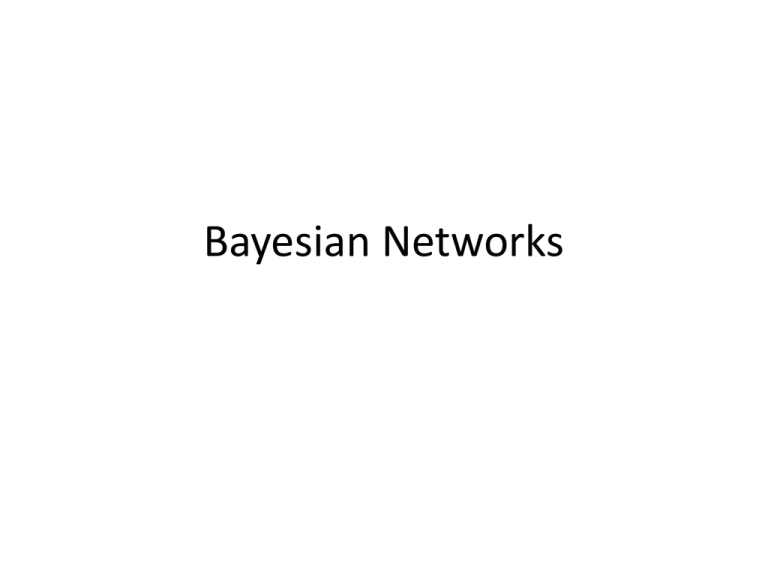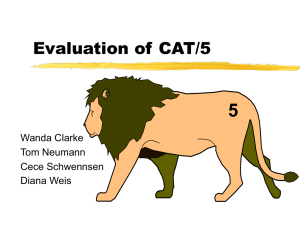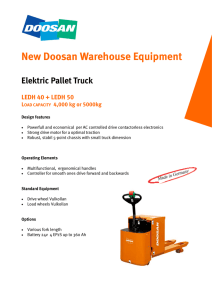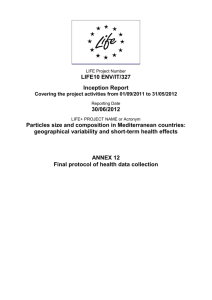pptx
advertisement

Bayesian Networks Quiz: Probabilistic Reasoning 1. What is P(F), the probability that some creature can fly? 2. Creature b is a bumble bee. What’s P(F|B), the probability that b can fly given that it’s a bumble bee? 3. b has unfortunately met a malicious child, who has torn off b’s wings. What is P(F|B,N), the probability that b can fly given that it has no wings? 4. b somehow makes its way onto a jumbo jet, where it survives by drinking juice spilled by passengers. What is P(F|B, N, L=j), the probability that b can fly given that it has no wings and its location is a jet? Example Has diabetes? (D or D) Unobservable node V = a set of random variables E = directed edges between them (cycles not allowed) Test was positive? (+ or -) Observable node Diab? Test? P(T|D) Diab? P(D) D 0.01 D 0.99 BN = (V, E, P) D + 0.9 D - 0.1 D + 0.2 D - 0.8 P = for every node in the network, a conditional probability distribution for that random variable, given its parents in the graph Simple probabilistic reasoning You already know how to figure out: • P(D) stored in the Bayes Net • P(+|D) stored in the Bayes Net • P(D,+) multiply P(D)P(+|D) • P(+) apply marginalization to P(D, +) • P(D|+) apply Bayes’ Rule Purpose behind Bayes Networks Battery age Alternator broken Battery dead Battery meter Lights Fan belt broken Not charging Battery flat Oil light No oil Gas gauge No gas Bayes Nets help figure out more difficult cases: What’s P(Battery Dead | Car won’t start, Battery is 5 years old)? or P(Alternator broken | Car won’t start, oil light is on, lights are dim)? Fuel line blocked Car won’t start dipstick Starter broken Types of Bayes Net Queries Bayes Nets let you solve “queries”, or probabilistic questions. There are different types of queries for a Bayes Net with random variables X1, …, XN: 1. Joint queries: What is P(car starts, oil light on)? 2. Conditional queries: What is P(alternator broken, battery light dim | oil light off, lights dim)? 3. Maximum a posteriori (MAP): what values (true or false) for “Will Car Start?” makes this probability the biggest: P(Will Car Start? | battery is 5 years old, lights dim) The Bayes Net Equation A BN specifies the joint distribution over all random variables in the graph, using this eqn: 𝑃 𝑋1 , … , 𝑋𝑁 = 𝑃 𝑋𝑖 |𝑝𝑎𝑟𝑒𝑛𝑡𝑠(𝑋𝑖 ) 𝑋𝑖 Example Has diabetes? (D or D) P(Diab, Test) = P(Diab|parents(Diab)) *P(Test|parents(Test)) Test was positive? (+ or -) = P(Diab) *P(Test|Diab) Quiz: Two-test Diabetes Diab? P(D) D 0.01 D 0.99 Has diabetes? (D or D) Test 1 was positive? (+ or -) Diab? Test1? 1. What is P(Test1=+|D)? P(T1|D) 2. What is P(Test1=+|D,Test2=+)? Test 2 was positive? (+ or -) Diab? Test2? 3. What is P(D|Test1=+,Test2=+)? P(T2|D) D + 0.9 D + 0.9 D - 0.1 D - 0.1 D + 0.2 D + 0.2 D - 0.8 D - 0.8 4. What is P(D|Test1=+,Test2=-)? Conditional Independence in a BN Has diabetes? (D or D) Test 1 was positive? (+ or -) Test 2 was positive? (+ or -) In this BN, T1 T2 | D This means, e.g.: P(T1=+|D, T2=+) is the same as P(T1=+|D) Quiz: Two-test Diabetes Has diabetes? (D or D) Test 1 was positive? (+ or -) Test 2 was positive? (+ or -) What is P(T1=+|T2=+)? Absolute vs. Conditional Independence Has diabetes? (D or D) Test 1 was positive? (+ or -) Test 2 was positive? (+ or -) Remember: T1 T2 | D Does this mean that T1 T2 ? In other words, P(T1) =? P(T1 | T2) S? P(D) S 0.7 S 0.3 Confounding Cause Sunny? (S or S) 1. What is P(R | S)? Raise? (R or R) Happy? (H or H) R? P(R) R 0.01 R 0.99 Happy? Sunny? Raise? P(H|S,R)? H S R 1.0 H S R 0.7 H S R 0.9 H S R 0.1 2. What is P(R | H, S)? 3. What is P(R | H,S)? 4. What is P(R | H)? Absolute vs. Conditional Independence Sunny? (S or S) Raise? (R or R) Remember: RS Does this mean that RS|H? Happy? (H or H) In other words, P(R | H) =? P(R | H, S) D-Separation D-separation is the technical method for determining conditional independence in a BN. Active Triplets Inactive Triplets … D-Separation Node A is d-separated (short for directional-separated) from node B if all paths from A to B contain at least one inactive triplet. A B | K1, …, Km nodes A and B are d-separated when nodes K1, …, Km are known D-Separation Quiz 1 C A? A C A | B? B D C D? C D | A? C E E C | D? D-Separation Quiz 2 A E? A B A E | B? A E | C? C A B? D E A B | C? D-Separation Quiz A C F F A? F A | D? B E F A | G? D H F A | H? G Counting BN Parameters A B C D E A complete joint distribution over 5 binary variables would require 31 = 25-1 parameters. This BN requires 10 = 1+1+4+2+2 parameters. Quiz A B E A full joint over 6 binary variables requires 26-1 = 63 parameters. C D F How many parameters does this network require? Quiz A B C A full joint distribution over 7 binary variables requires 27-1 = 127 parameters. D E F G How many parameters does this network require? Quiz Battery age Alternator broken Battery dead Battery meter Lights A full joint distribution over Fan belt 16 binary variables requires 16 broken 2 -1 = 65,535 parameters. How many parameters does this network require? Not charging Battery flat Oil light No oil Gas gauge No gas Fuel line blocked Car won’t start dipstick Starter broken







